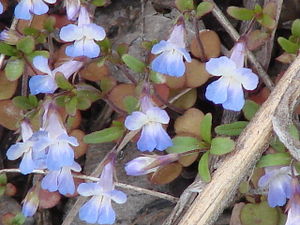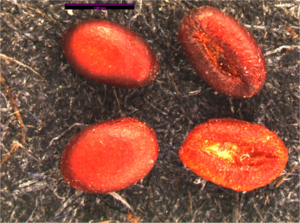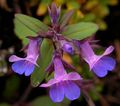Difference between revisions of "Collinsia parviflora"
(→Taxonomy) |
(Tag: VisualEditor) |
||
| Line 73: | Line 73: | ||
<gallery> | <gallery> | ||
File:COPA BenLegler sdh good.jpg| Photo by Ben Legler | File:COPA BenLegler sdh good.jpg| Photo by Ben Legler | ||
| − | File: | + | File:COLPAR8.jpg| Ben Legler 2004 |
File:COLPAR2.jpg|Seedlings, courtesy CNLM | File:COLPAR2.jpg|Seedlings, courtesy CNLM | ||
File:COLPAR3.jpg|Seedlings, courtesy CNLM | File:COLPAR3.jpg|Seedlings, courtesy CNLM | ||
</gallery> | </gallery> | ||
| + | <references /> | ||
Revision as of 21:14, 19 March 2021
- Latin Name: Collinsia parviflora
- Family: Plantaginaceae
- Common Names: small-flowered blue-eyed Mary, collinsia
- Synonyms/Misapplications: Collinsia grandiflora
- Codon: COLPAR
Contents
Taxonomy
| Collinsia parviflora | |
|---|---|

| |
| Photo by Craig Althen, 2010. Featured on Main Page | |
| Scientific classification | |
| Kingdom: | Plantae |
| Subkingdom: | Viridiplantae |
| Phylum: | Tracheophyta |
| Subphylum: | Spermatophytina |
| Class: | Magnoliopsida |
| Subclass: | Asteranae |
| Order: | Lamiales |
| Family: | Plantaginaceae |
| Genus: | Collinsia Nutt. |
| Species: | Collinsia parviflora Lindl. |
| Synonyms | |
| |
Description
Annual herb 5-40 cm tall from a taproot. Leafy stems usually erect of ascending, however, sometimes long and sprawling; may be simple or branched. Middle and upper
leaves: are opposite (or whorled), oblong to lance-shaped, 1-4 cm long, though smaller and bract-like in the inflorescence. Lower leaves are oblong to spoon-shaped and are stalked. Leaves are usually hairless while stems are often covered in minute hairs that may be glandular.
Flowers: are two-lipped, 4-8 mm long. The upper lip is white and two lobed; the lower lip is blue and three lobed; four stamens. Flowers are borne in the leaf axils on hairy stalks. Fruit is a smooth, reddish-brown capsule 3-5 mm long, football-shaped, usually bearing four seeds (Pojar and MacKinnon, 1994).
Bloom Period
April - June
Distribution
Occurs in BC extending south to California and east to Manitoba, Michigan, Colorado and Arizona (Pojar and MacKinnon, 1994; Ganders and Krause, 1986; Elle, 2002).
Habitat
Rocky outcrops in coastal Douglas-fir zone. Areas that dry out rapidly in summer. Low to middle elevations but occasionally higher. Absent from the wet outer coast.
Seed
Abbreviation: COPA
Seed sample from: 2011
Average measurement: 0.7 x 1.5 x 1
Measurement range: L: 0.5 - 0.9, W: 1.3 x 1.7, D: 0.9 x 1.3
Features
Color Seeds bright red with elliptical, white, large depression that is the hilium on a longer seed side.
Surface Seeds red, matte, and very slightly bumpy. Possibly smoother than COGR. Some seeds have seed coat ridges at the edge of the seed, giving it a somewhat winged look.
Seed slightly larger than Collinsia grandiflora.
Could be confused with: Collinsia grandiflora.
Latitudinal cross section: elliptical ![]()
Longitudinal cross section: irregular
Basic Explanations and Assumptions:
The dimensions for the seeds are length x width x depth. The location of the hilum is used as the base of the seed, and the length is measured from hilum to the opposite apex. Where a style is present, the length is measured from the hilum to the bottom of the style. Width is measured at a right angle to the length at the widest part. Depth is measured at a right angle to the intersection of height and width lines.
Measurements included are the mean average for each measurement of ten separate seeds.
All measurements in millimeters unless otherwise noted.
References
Photo Gallery
- ↑ Integrated Taxonomic Information System. Retrieved from https://www.itis.gov/servlet/SingleRpt/SingleRpt?search_topic=TSN&search_value=33534





